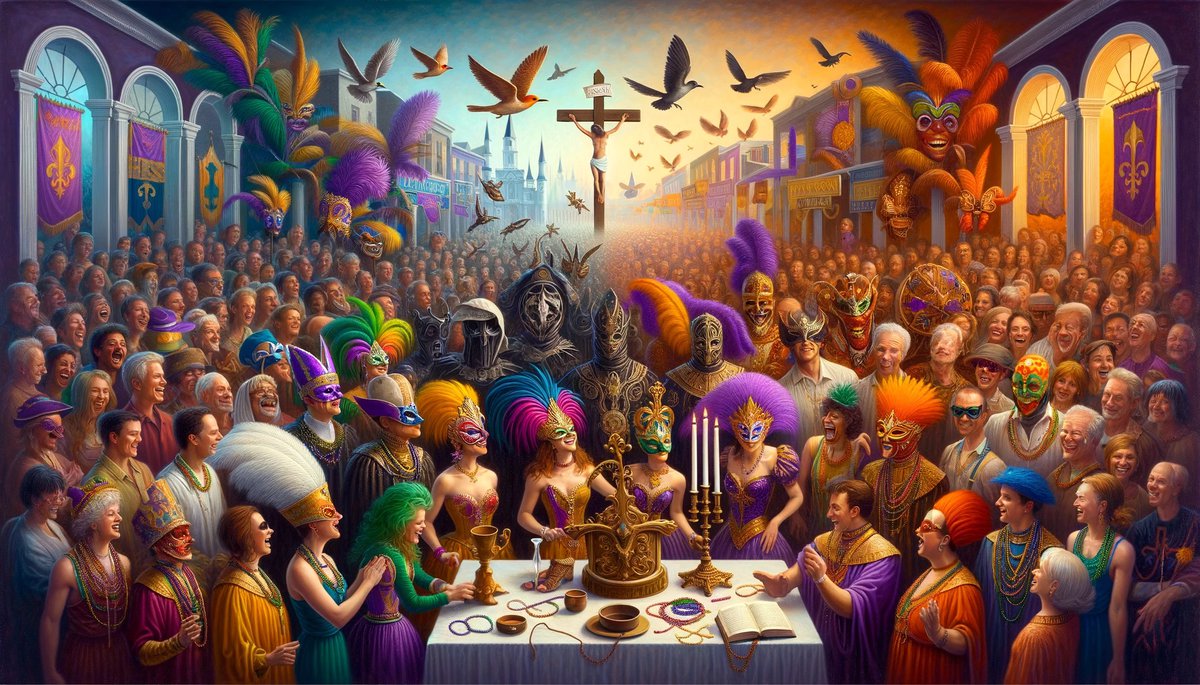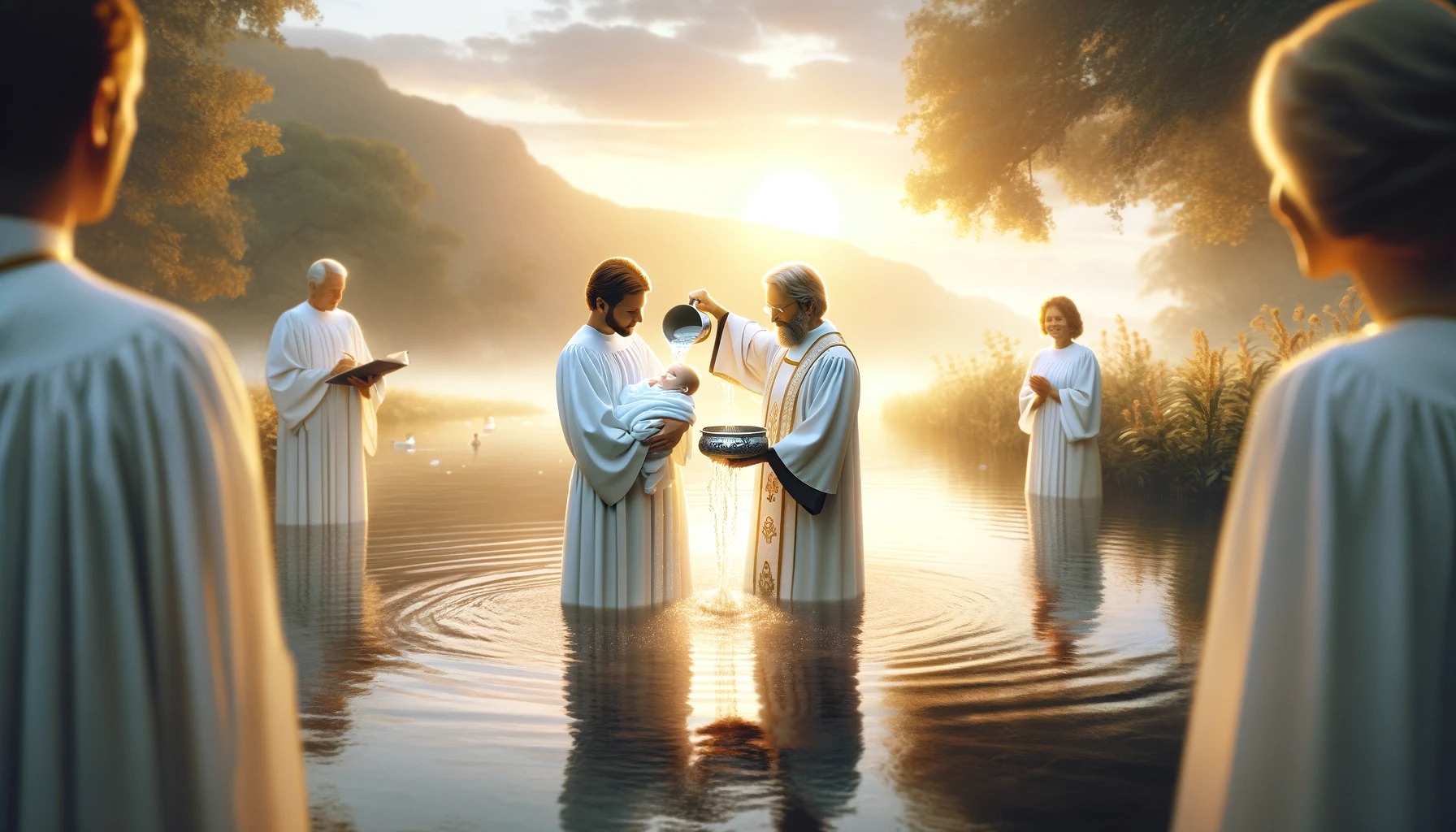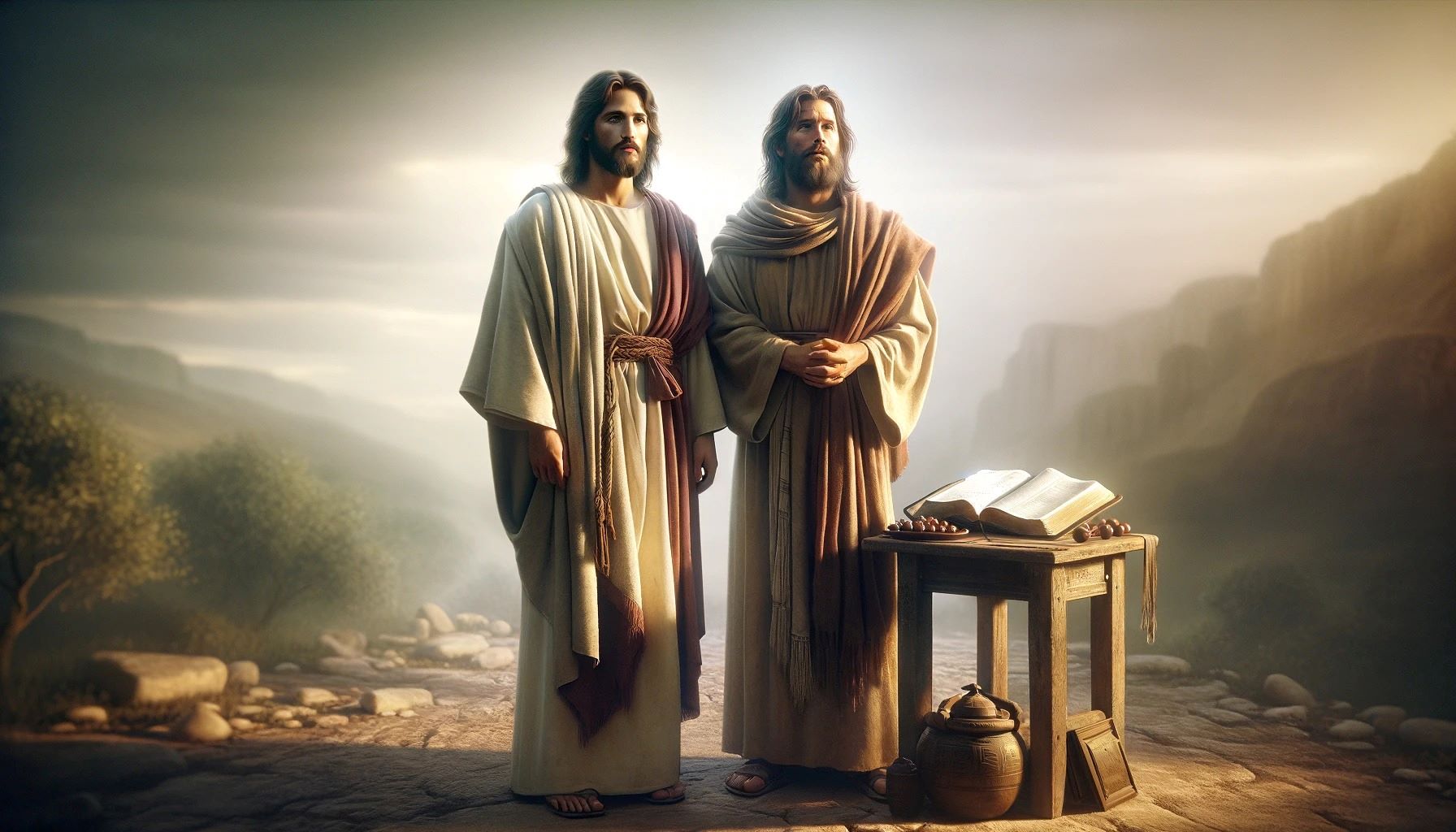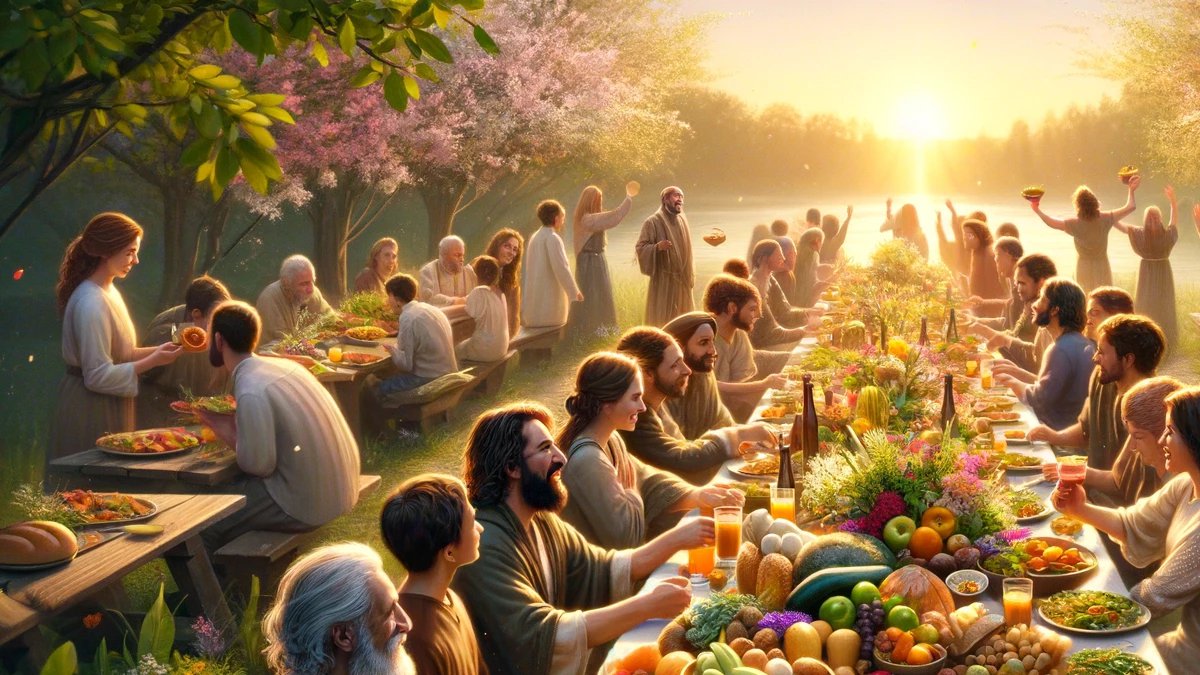Home>Special Themes>How Does Mardi Gras Related To Lent


Special Themes
How Does Mardi Gras Related To Lent
Published: February 28, 2024
Ericka Andersen, an editor at Christian.net, expertly merges digital strategy with content creation, focusing on faith and societal issues. Her communication skills enhance the platform's engaging narratives, fostering meaningful dialogue on belief's impact on society.
Discover the connection between Mardi Gras and Lent, and explore the special themes that tie these two traditions together. Uncover the significance of special themes in the context of Mardi Gras and Lent.
(Many of the links in this article redirect to a specific reviewed product. Your purchase of these products through affiliate links helps to generate commission for Christian.net, at no extra cost. Learn more)
Table of Contents
The Origins of Mardi Gras
-
Ancient Roman Festivals: Mardi Gras, also known as Fat Tuesday, has its roots in ancient Roman festivals like Saturnalia and Lupercalia. These festivals were known for their merrymaking, feasting, and revelry. When Christianity spread to Rome, the early Church incorporated these festivities into the pre-Lenten period.
-
Christian Adaptation: The Christian tradition of Mardi Gras began as a way to indulge before the solemn season of Lent. It was a time for people to enjoy rich foods, celebrate, and engage in excesses before the fasting and abstinence of the Lenten season.
-
Spread to France: The tradition of Mardi Gras was brought to France by the Romans. Over time, it evolved into a celebration marked by masquerade balls, parades, and lavish feasts. The French phrase "Mardi Gras" translates to "Fat Tuesday," reflecting the practice of consuming rich, fatty foods before the Lenten fast.
-
Colonial Influence: When French settlers brought the tradition of Mardi Gras to the United States, it merged with local customs and evolved into the vibrant and colorful festival known today. The city of New Orleans, in particular, became synonymous with elaborate Mardi Gras celebrations, featuring parades, music, and elaborate costumes.
-
Cultural Diversity: As Mardi Gras spread to different regions, it absorbed elements from various cultures, resulting in a diverse tapestry of traditions and customs. Today, Mardi Gras is celebrated in many countries around the world, each adding its unique flair to the festivities.
-
Symbolism: The colors of Mardi Gras, purple, green, and gold, hold symbolic significance. Purple represents justice, green symbolizes faith, and gold signifies power. These colors are prominently featured in the decorations, costumes, and floats during Mardi Gras parades.
-
Community and Celebration: Mardi Gras has become a time for communities to come together in revelry and joy. It is a celebration of life, diversity, and the human spirit, fostering a sense of unity and camaraderie among participants. The origins of Mardi Gras reflect a blend of ancient traditions, Christian practices, and cultural influences, resulting in a vibrant and exuberant festival that continues to captivate people worldwide.
Read more: What Is Lent And Mardi Gras?
The Significance of Lent in Christianity
-
Spiritual Preparation: Lent is a period of spiritual preparation, reflection, and renewal for Christians around the world. It spans approximately 40 days, symbolizing the time Jesus spent fasting in the wilderness. During this season, believers are encouraged to engage in prayer, repentance, and self-denial as a means of drawing closer to God.
-
Fasting and Abstinence: One of the central aspects of Lent is fasting and abstinence. This practice is rooted in the biblical accounts of Jesus' fasting and temptation in the wilderness. By abstaining from certain foods or activities, Christians seek to discipline their bodies and focus on their spiritual journey.
-
Penitence and Reconciliation: Lent provides a dedicated period for believers to engage in acts of penitence and seek reconciliation with God and others. It is a time to acknowledge shortcomings, seek forgiveness, and strive for inner transformation.
-
Preparation for Easter: The culmination of Lent is the celebration of Easter, the most significant event in the Christian calendar. Lent prepares individuals and the church as a whole to fully embrace the profound significance of Christ's death and resurrection.
-
Renewal of Faith: Through the observance of Lent, Christians are given the opportunity to renew their faith, deepen their commitment to Christ, and realign their priorities with the teachings of the Gospel.
-
Community and Communal Worship: Lent is not only a personal journey but also a communal experience. Many churches hold special services, prayer gatherings, and communal acts of charity during this season, fostering a sense of unity and shared purpose among believers.
-
Symbolism of Forty Days: The forty-day duration of Lent holds symbolic significance, representing the period of testing and preparation. It mirrors the forty days Jesus spent in the wilderness, as well as the forty days of rain during the biblical flood and the forty years the Israelites wandered in the desert.
-
Spiritual Disciplines: Lent encourages the practice of spiritual disciplines such as meditation, almsgiving, and acts of service. These disciplines are intended to cultivate a deeper spiritual awareness and a heightened sense of compassion for others.
-
Preparation for Baptism: In some Christian traditions, Lent is a time of preparation for those seeking baptism or confirmation. It serves as a period of instruction, reflection, and spiritual formation for individuals preparing to make a public commitment to their faith.
-
Emphasis on Sacrifice and Service: Lent emphasizes the values of sacrifice and service, calling believers to emulate Christ's selflessness and compassion. It prompts individuals to consider how they can contribute to the well-being of others and make a positive impact in their communities.
Lent holds profound significance in the Christian faith, serving as a transformative and spiritually enriching season for believers as they journey towards the celebration of Easter.
The Connection Between Mardi Gras and Lent
-
Pre-Lenten Celebration: Mardi Gras, or Fat Tuesday, is intricately connected to the season of Lent in the Christian calendar. It serves as the culmination of the pre-Lenten festivities, providing a final opportunity for indulgence and revelry before the solemn observance of Lent begins.
-
Historical Transition: The link between Mardi Gras and Lent can be traced back to the historical transition from pagan festivals to Christian observances. As Christianity spread and evolved, it absorbed and transformed existing cultural practices, including the exuberant celebrations that preceded the Lenten period.
-
Indulgence and Abstinence: The juxtaposition of Mardi Gras and Lent reflects the contrast between indulgence and abstinence. While Mardi Gras is characterized by feasting, merry-making, and excess, Lent calls for fasting, self-discipline, and spiritual introspection. This transition from revelry to restraint symbolizes the shift from worldly pleasures to spiritual devotion.
-
Symbolic Transition: Mardi Gras, with its lavish parades, elaborate costumes, and festive atmosphere, symbolizes a temporary departure from everyday routines and responsibilities. It provides a space for individuals to engage in joyful celebration before embracing the introspective and penitential nature of the Lenten season.
-
Spiritual Preparation: The connection between Mardi Gras and Lent underscores the concept of spiritual preparation. By engaging in exuberant festivities before the onset of Lent, individuals are symbolically preparing themselves for the spiritual discipline and self-examination that characterize the Lenten journey.
-
Cultural Traditions: Across different cultures and regions, the connection between Mardi Gras and Lent is manifested through a rich tapestry of cultural traditions. From the masquerade balls of Venice to the vibrant parades of New Orleans, these celebrations serve as a bridge between the joyous abandon of Mardi Gras and the introspective solemnity of Lent.
-
Transition to Reflection: Mardi Gras acts as a transitional period, allowing individuals to release inhibitions, express creativity, and partake in communal festivities. This serves as a symbolic prelude to the introspective period of Lent, where believers are called to reflect on their faith, seek spiritual renewal, and deepen their relationship with God.
-
Continuation of Tradition: The connection between Mardi Gras and Lent endures as a testament to the dynamic interplay between secular revelry and religious observance. It highlights the multifaceted nature of human experience, encompassing moments of joyous celebration as well as periods of solemn contemplation and spiritual growth.
-
Harmony of Contrasts: The juxtaposition of Mardi Gras and Lent embodies the harmony of contrasts within the Christian faith. It encapsulates the duality of human existence, acknowledging the need for both celebration and introspection, indulgence and restraint, as integral components of the spiritual journey.
-
Culmination and Commencement: Ultimately, the connection between Mardi Gras and Lent represents the culmination of one season and the commencement of another. It marks a symbolic shift from festivity to fasting, from external expressions of joy to internal reflections, encapsulating the cyclical nature of spiritual life and the rhythm of the Christian liturgical calendar.
Traditions and Celebrations During Mardi Gras
-
Parades and Floats: Mardi Gras is renowned for its elaborate parades featuring colorful floats, marching bands, and costumed revelers. These parades wind through the streets of cities and towns, captivating spectators with their vibrant displays and exuberant energy.
-
Masked Balls and Galas: Masquerade balls and galas are a hallmark of Mardi Gras celebrations, particularly in regions with a strong French influence. Attendees don ornate masks and elegant attire, immersing themselves in a world of mystery, intrigue, and enchantment.
-
Carnival Krewes: Social clubs known as krewes play a central role in organizing Mardi Gras festivities. These krewes host lavish balls, design intricate floats, and orchestrate the pageantry of the parades, contributing to the rich tapestry of traditions that define Mardi Gras.
-
Bead-Throwing and Trinkets: A beloved tradition during Mardi Gras parades is the tossing of colorful beads, trinkets, and doubloons to the cheering crowds. This act of generosity and revelry adds to the festive atmosphere and creates a sense of camaraderie among participants.
-
King Cake: The King Cake holds special significance during Mardi Gras. This sweet, circular pastry is adorned with purple, green, and gold icing, symbolizing justice, faith, and power. Baked within the cake is a tiny figurine, and whoever finds it is bestowed with good luck and the honor of hosting the next gathering.
-
Music and Dance: Mardi Gras is infused with the pulsating rhythms of jazz, blues, and zydeco music. Street performers, live bands, and impromptu dance parties animate the festival, inviting attendees to sway to the infectious beats and revel in the joy of the moment.
-
Costumes and Masquerade: Dressing in elaborate costumes and masks is a cherished tradition during Mardi Gras. Participants express their creativity and imagination through flamboyant attire, transforming the streets into a kaleidoscope of colors and characters.
-
Street Festivities and Feasting: Alongside the organized parades and balls, Mardi Gras engenders spontaneous street festivities, where locals and visitors alike come together to savor delectable cuisine, share in the revelry, and immerse themselves in the vibrant tapestry of cultural expressions.
-
Historical Reenactments and Pageantry: Some Mardi Gras celebrations incorporate historical reenactments and pageantry, paying homage to the rich heritage and traditions that have shaped the festival over the centuries. These reenactments add depth and historical context to the modern-day revelry.
-
Community Engagement and Volunteerism: Mardi Gras also serves as a platform for community engagement and volunteerism. Many participants and organizations use the festival as an opportunity to give back to the community through charitable acts and initiatives, embodying the spirit of compassion and goodwill.
Mardi Gras is a tapestry of traditions, customs, and celebrations that reflect the diversity, creativity, and communal spirit of the communities that embrace this exuberant festival.
How Mardi Gras Prepares for the Lenten Season
-
Catharsis and Release: Mardi Gras serves as a period of catharsis and release before the onset of Lent. It provides individuals with an opportunity to engage in joyful celebration, express creativity, and partake in communal festivities. This sense of liberation and revelry acts as a symbolic prelude to the introspective and penitential nature of the Lenten season.
-
Indulgence and Restraint: The contrast between the indulgence of Mardi Gras and the restraint of Lent underscores the transition from worldly pleasures to spiritual devotion. By engaging in exuberant festivities before the commencement of Lent, individuals symbolically prepare themselves for the spiritual discipline and self-examination that characterize the Lenten journey.
-
Reflection and Renewal: Mardi Gras encourages individuals to reflect on the significance of the upcoming Lenten season. It serves as a time for introspection, fostering an awareness of the impending period of fasting, prayer, and spiritual renewal. The vibrant celebrations of Mardi Gras prompt individuals to contemplate the deeper spiritual meanings associated with the forthcoming season of Lent.
-
Community and Camaraderie: Mardi Gras fosters a sense of community and camaraderie, bringing people together in revelry and joy. This communal spirit prepares individuals to embark on the Lenten journey with a sense of solidarity and shared experience. The connections forged during Mardi Gras carry over into the Lenten season, providing a support network for individuals as they engage in acts of prayer, fasting, and reflection.
-
Symbolic Transition: The transition from Mardi Gras to Lent represents a symbolic shift from external expressions of joy to internal reflections. It encapsulates the cyclical nature of spiritual life and the rhythm of the Christian liturgical calendar. This transition prepares individuals to embrace the solemnity and spiritual significance of the Lenten season, marking a shift from festive revelry to a period of spiritual introspection and renewal.
-
Cultural Traditions and Symbolism: The traditions and symbolism of Mardi Gras, including the vibrant colors, elaborate costumes, and festive parades, serve as a bridge between the joyous abandon of Mardi Gras and the introspective solemnity of Lent. These cultural expressions and symbols prepare individuals for the transition from outward expressions of celebration to inner contemplation and spiritual growth.
-
Preparation for Spiritual Discipline: Mardi Gras acts as a precursor to the spiritual discipline of Lent, prompting individuals to consider the significance of the upcoming season. It serves as a reminder of the need for spiritual preparation, self-examination, and a renewed commitment to faith. The exuberant festivities of Mardi Gras prepare individuals to embrace the disciplines of prayer, fasting, and almsgiving that characterize the Lenten season.
-
Embrace of Contrasts: The juxtaposition of Mardi Gras and Lent embodies the harmony of contrasts within the Christian faith. It acknowledges the need for both celebration and introspection, indulgence and restraint, as integral components of the spiritual journey. This preparation for the Lenten season through the celebration of Mardi Gras underscores the multifaceted nature of human experience and the dynamic interplay between secular revelry and religious observance.
In summary, Mardi Gras serves as a vibrant and symbolic preparation for the Lenten season, offering individuals a period of release, reflection, and communal celebration before embracing the spiritual disciplines and introspective journey of Lent.















